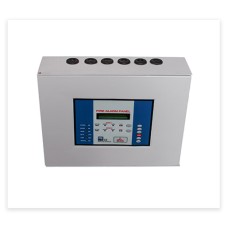A 4 Zone Fire Alarm Panel is a fire detection system designed to monitor and control up to four separate areas or zones within a building or premises. It is a more advanced fire alarm panel compared to a 2-zone system, offering greater flexibility for larger buildings or areas with multiple distinct fire risks. Each zone can be independently monitored for fire hazards, and the panel will alert the occupants or operators to any fire-related incidents in the designated zones. Key Features of a 4 Zone Fire Alarm Panel: Four Zone Monitoring: The 4-zone panel can monitor and control four separate zones in a building or premises. Each zone can consist of a set of smoke detectors, heat detectors, manual call points, or other fire detection devices. The four zones allow for greater flexibility, making the panel suitable for larger buildings where fire risks are spread across different areas, such as floors, wings, or sections of a building. Fire Detection Devices: The panel is connected to a variety of fire detection devices: Smoke detectors: Detect smoke particles in the air, indicating the potential presence of a fire. Heat detectors: Activate the alarm when a fire causes the temperature in an area to exceed a certain threshold. Manual call points: Allow people to manually trigger the alarm if they spot a fire. Gas detectors: Some panels may support additional detectors for gas hazards, such as carbon monoxide. Audible and Visual Alarms: When the fire alarm panel detects a fire or hazard, it triggers both audible alarms (siren, bell, or horn) and visual alarms (flashing lights or beacons) to alert the building’s occupants to evacuate the premises immediately. These alarms will also include a signal indicating which of the four zones has been activated, helping emergency responders quickly identify the location of the fire. Zone Status Indicators: A 4 Zone Fire Alarm Panel typically has indicator lights or digital displays for each of the four zones, showing their status (e.g., normal, alarm, fault, or active). These visual indicators help operators quickly identify which zone has a fire or fault, improving response time. The status indicators are often color-coded (e.g., green for normal, red for alarm) to help users quickly understand the system’s condition. Manual and Automatic Alarm Activation: The fire alarm panel can be triggered automatically by connected detectors (smoke or heat sensors) or manually by using a manual call point, where anyone who detects a fire can activate the alarm. In case of an alarm, the panel will display the specific zone where the alarm has been triggered. Test and Reset Functions: The panel includes test functions to ensure that all detectors and devices are functioning correctly. After an alarm event, a reset function is used to clear the alarm condition once the issue has been addressed, or in the case of a false alarm. Battery Backup: To ensure the system continues to function during power outages, the panel is typically equipped with a battery backup. This ensures that the fire alarm system remains operational even if the main electrical supply is interrupted. Compliance with Fire Safety Standards: A 4 Zone Fire Alarm Panel is designed to comply with local or international fire safety regulations, such as the BS 5839 standard in the UK, NFPA in the US, or similar codes in other countries. The system must meet rigorous testing requirements to ensure it performs reliably during an emergency. Expansion Capability: Some 4-zone panels can be connected to additional panels to expand the system if more zones are required. This allows for flexibility and scalability in larger buildings. Networking and Integration: The panel may also be integrated with other safety and emergency systems, such as sprinkler systems, emergency lighting, public address systems, or ventilation systems. Integration ensures that when an alarm is triggered, other safety measures (like sprinklers or emergency exits) can be activated automatically to help contain the fire.
Send Message
